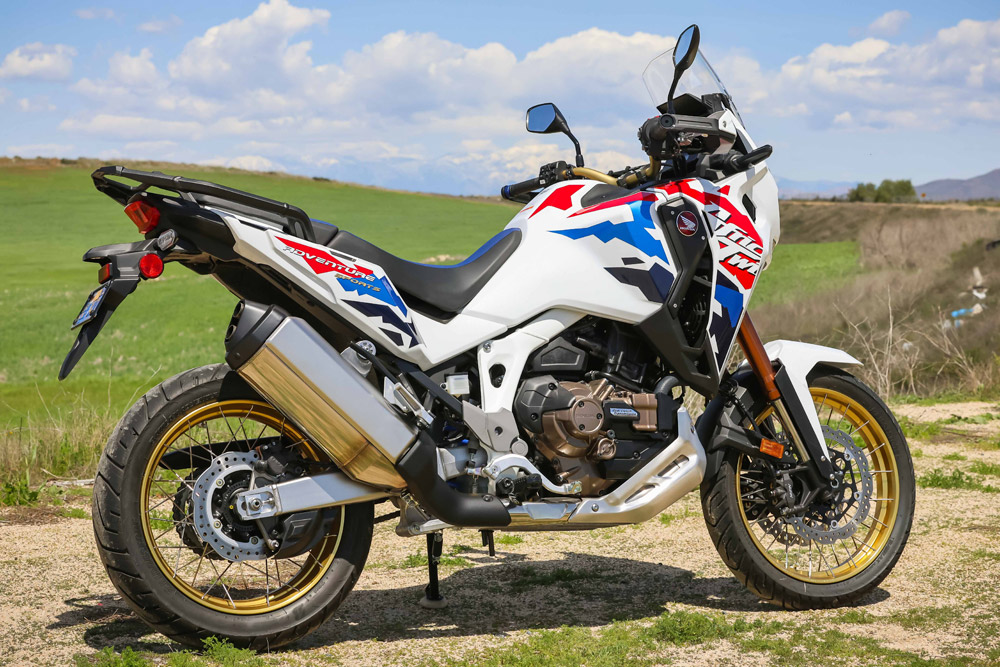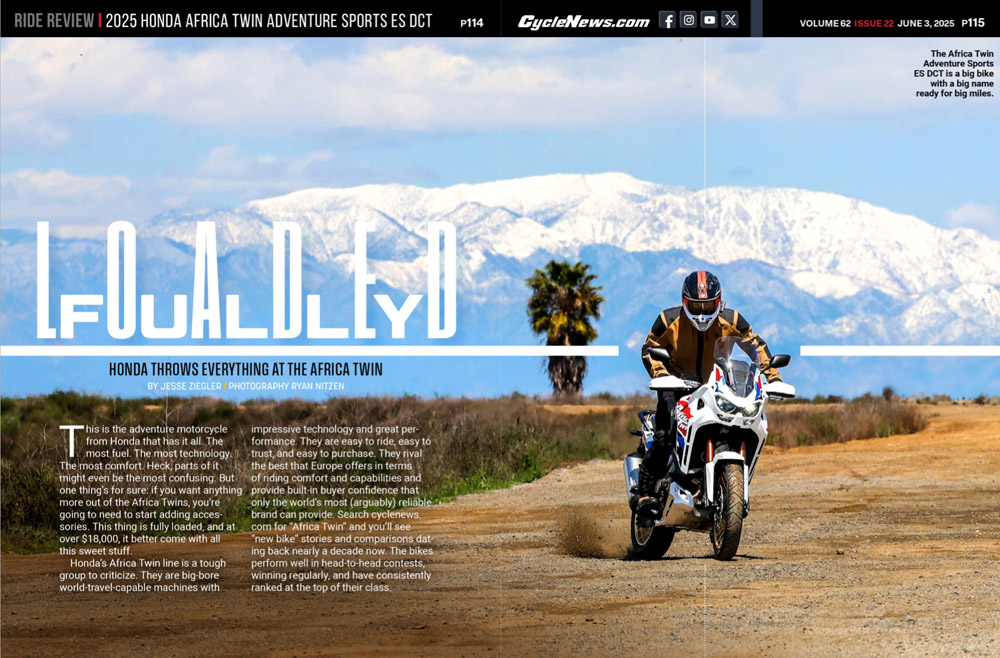This is the adventure motorcycle from Honda that has it all. The most fuel. The most technology. The most comfort. Heck, parts of it might even be the most confusing. But one thing’s for sure: if you want anything more out of the Africa Twins, you’re going to need to start adding accessories. This thing is fully loaded, and at over $18,000, it better come with all this sweet stuff.
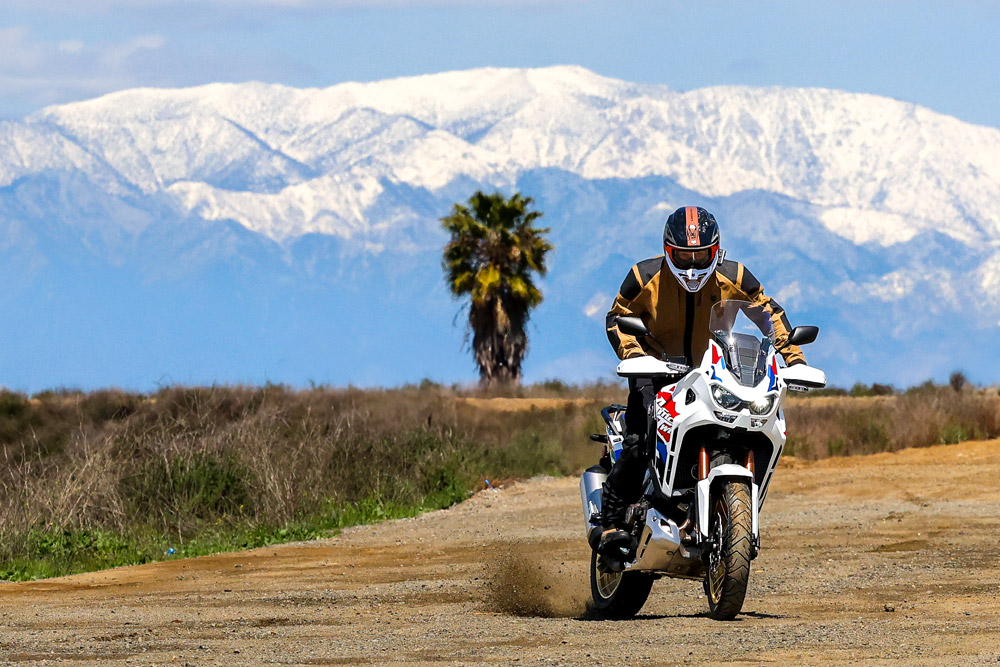
Photography Ryan Nitzen
Honda’s Africa Twin line is a tough group to criticize. They are big-bore world-travel-capable machines with impressive technology and great performance. They are easy to ride, easy to trust, and easy to purchase. They rival the best that Europe offers in terms of riding comfort and capabilities and provide built-in buyer confidence that only the world’s most (arguably) reliable brand can provide. Search cyclenews.com for “Africa Twin” and you’ll see “new bike” stories and comparisons dating back nearly a decade now. The bikes perform well in head-to-head contests, winning regularly, and have consistently ranked at the top of their class.
Since the introduction of the new generation in 2016, Honda has consistently updated its models and expanded its range of technology and features to stay ahead of ADV trends. They’ve added ride-by-wire throttle, a six-axis IMU, and lean-angle recognition for enhanced traction, braking, and shifting control. They’ve improved ergonomics and wind protection, incorporating a large touchscreen display to manage all the functions. Additionally, they’ve included tubeless spoked wheels and cruise control, and they’ve increased the engine output to 1084cc of parallel-twin goodness with impressive torque thanks to a 270-degree firing pattern. It also sounds cool.
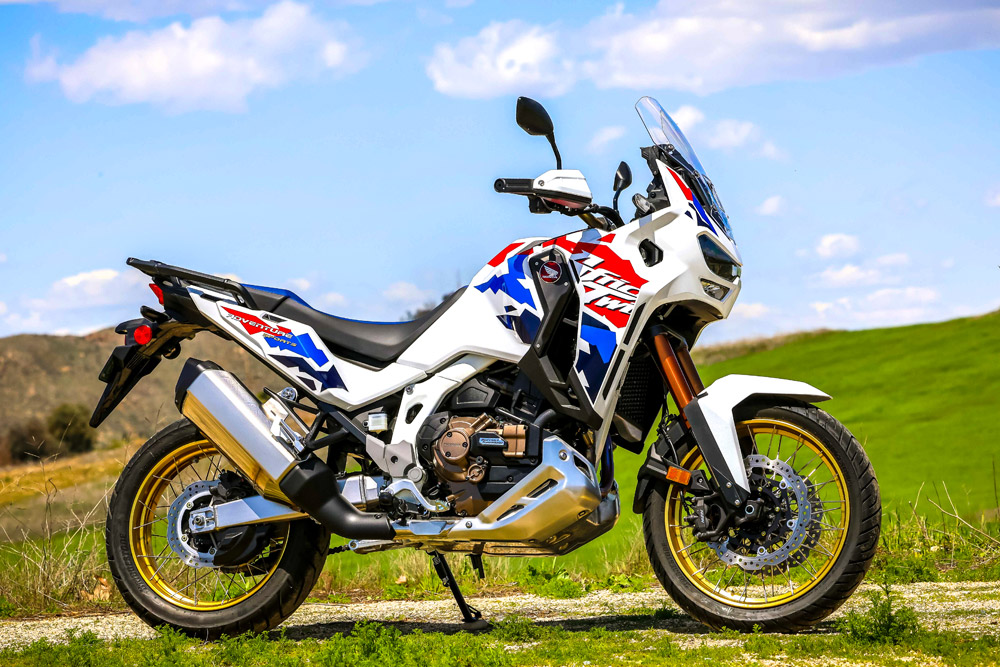
In general, Africa Twins are well equipped and ready to rip. And we’ve told you so for a long time. None of this is that new. But, since this is the most fully loaded Africa Twin you can get, we thought it was worth another ride.
With all that said, the Africa Twin used to be very simple. Like, painfully simple, as we remember just riding without having to think about how to adjust, well, anything. But as the updates came flooding in, so has the complexity and performance output. We won’t dwell on the old days any longer or delve into the history of the Africa Twin here. Instead, let’s keep our focus on the biggest, baddest Africa Twin you can buy, and why you might want to.
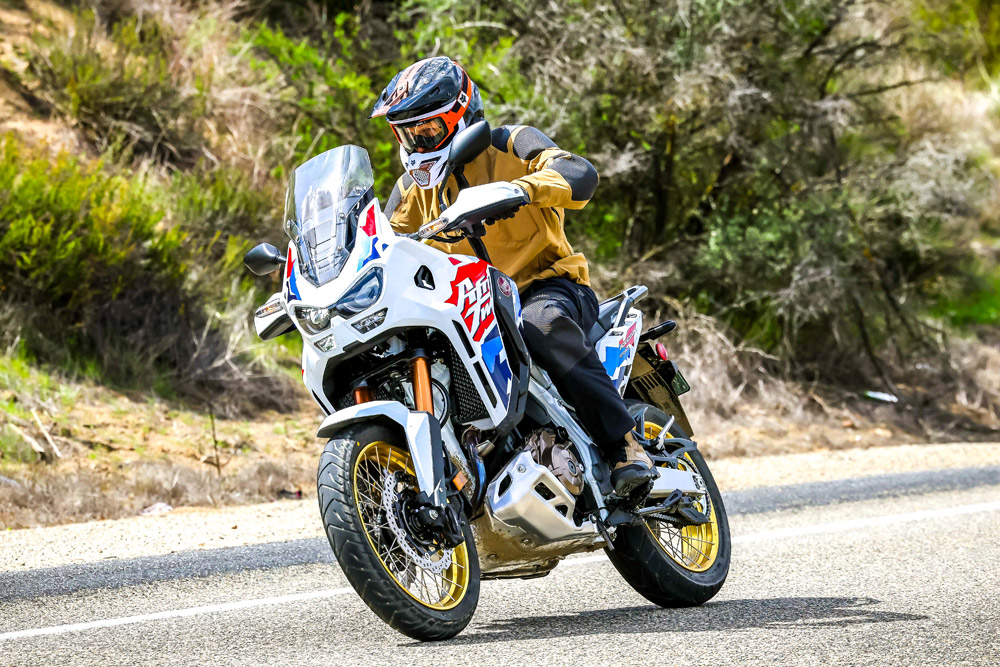
The Adventure Sports World
The Adventure Sports model was first introduced as a 2019 model at a product launch I attended in 2018. Its name signifies that you’re entering a world of longer-distance and more comfortable adventure touring on the street. The fuel capacity of all Adventure Sports versions has been increased to 6.6 gallons, up from 5.0 in the standard Africa Twin. On top of the tank sits a larger, more aerodynamic fairing designed to deflect high-mileage wind. Additionally, you receive a 19-inch front wheel and the Showa Electronically Equipped Ride Adjustment (EERA) suspension. This suspension provides slightly less travel than that of the standard model, with 8.3 inches in the front and 7.9 inches in the rear (standard Africa Twins feature 9.0 inches and 8.7 inches, respectively). These changes—the front wheel and suspension—result in a lower seat height on the Adventure Sports, which is adjustable in two positions from 32.9 to 33.7 inches in low/high settings, approximately half an inch lower than the standard version’s options. These differences (more fuel, more wind protection, smaller front wheel, electronic suspension) are essentially what make an Africa Twin an Africa Twin Adventure Sports. But, let’s dig even deeper into the fully loaded version.

The DCT Difference
Honda’s Dual Clutch Transmission (DCT) is available on any Africa Twin. However, using it on this model is, in my opinion, the best fit for adventure motorcycling. It shines here and truly belongs here. I absolutely loved having it, and my only complaint about it on a touring bike is that it makes me super lazy. I don’t even bother with the manual setting (see below); I just let the DCT robot completely take over. If I’m touring on the street, why not?
DCT has been around for a long time now. From ATVs and sport-touring bikes in the early 2000s to the Talon family of sport side-by-sides, DCT has delivered automatic transmission ease-of-use into durable manual transmission systems. Honda says approximately half of all global Africa Twin owners have DCT. We’re guessing that ratio is higher in Europe.
DCT is essentially an electronically controlled hydraulic clutch system that operates two overlapping clutches simultaneously—one clutch manages startup, first, third and fifth gears, while the second handles second, fourth and sixth gears. During operation, the system pre-selects the upcoming gear for shifting through the disengaged clutch. Then, the clutches switch roles, and power is transferred. The shifts are remarkably smooth and surprisingly direct and enjoyable.
You can control DCT in a few different ways based on your preference. There are three modes: Drive, Sport, and Manual. Drive is straightforward and somewhat boring, which is as intended. It’s like a car. Sport becomes more exciting with higher rev levels between shifts and quicker downshifts when decelerating. This creates a sporty feel, and you can customize the Sport mode with three levels for even more sportiness. Manual moves the gear-decision-making to your hands via triggers on the controls. You determine when to shift, and it listens—when appropriate. You can also use the manual up/down triggers in Drive and Sport modes to “drop a gear,” for instance. After the manual shift, the system will revert to auto mode.
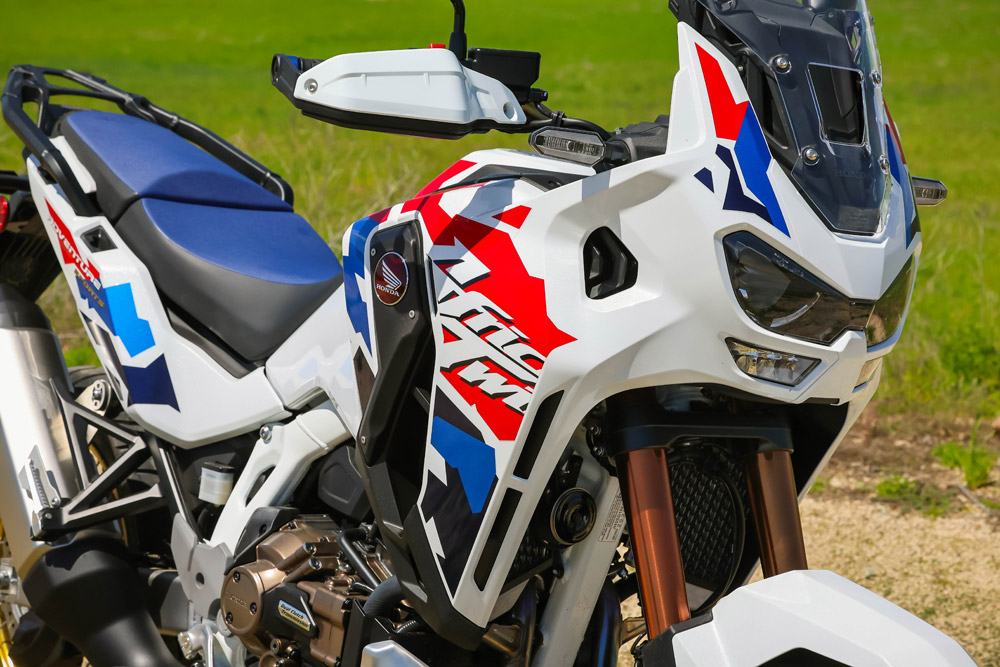
Some cool tech integration to remember here: all this DCT business is optimized by the on-board IMU, measuring things like vehicle speed, throttle position and gear position, to ensure an errant downshift doesn’t upset the chassis. It also detects incline and will change its shifting brain a bit on steeper hills.
The final word on DCT tech is the G-Switch. This is mostly for off-road use but can be useful if you like a certain feel for your clutch engagement or if you want to get spicy and slide the rear end on the gas, for example. The G-Switch function simply reduces clutch slip and allows more aggressive power to the rear wheel. This is good in off-road situations when you don’t want the lag of clutch drag. All in, DCT adds about 25 pounds to the bike.
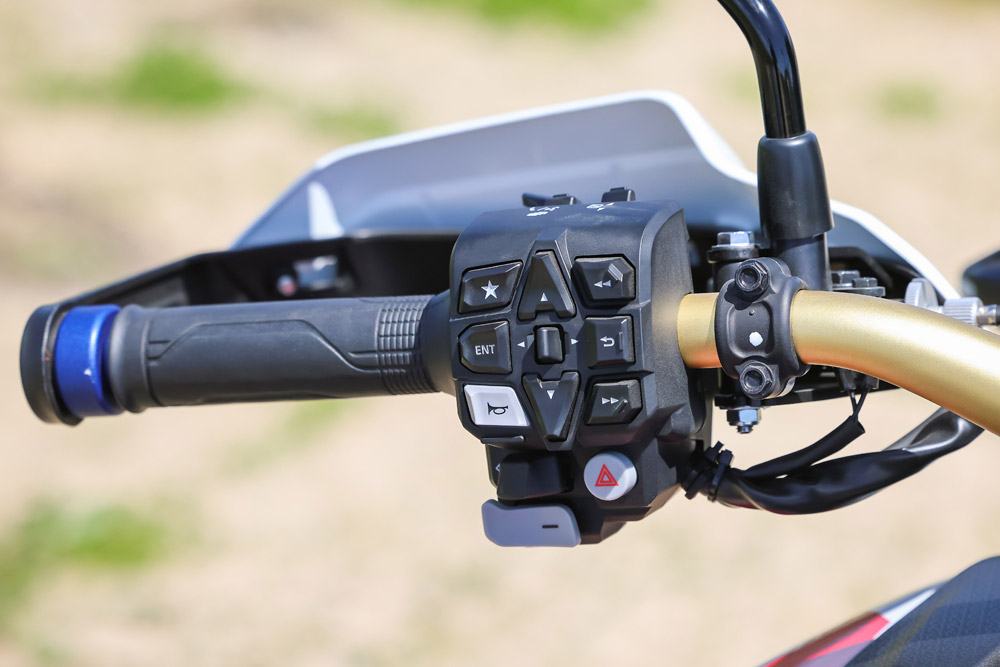
Electronically Controlled Ground Control
Showa’s Electronically Equipped Ride Adjustment (EERA) suspension system is an Adventure Sports exclusive in the Africa Twin range. And much like DCT previously mentioned, it fits on the big-daddy adventure touring weapon perfectly. While the overall travel is down a bit from the standard AT’s, this thing still has plenty of travel for all road and light off-road use. And, while the AS version is clearly more street-biased, it still comes equipped with a 45mm fork up front.
The EERA system takes ride diagnostic information from the bike’s ECU, IMU and a stroke sensor in the suspension itself to calculate damping changes in about 15 milliseconds. Honda pre-programmed four suspension modes into the system, including a fifth customizable mode. Modes range from offering low-speed ride comfort to higher-speed stability and even off-road performance. Mode names like Hard, Mid, Soft and Off-Road make sense. These programmed modes are linked to the various preloaded ride modes in the bike’s brain. These modes trigger different power delivery, traction control (Honda calls theirs HSTC or Honda Selectable Torque Control), engine braking, ABS settings, as well as these suspension modes, depending on the planned riding scenario. Riding modes have been covered extensively, but for a recap, they include Tour, Urban, Gravel and Off-Road, and a couple of customizable user modes you can make your own. Also included in the suspension department is electronic preload adjustment. Need to give your friend a lift or load up for massive days of camping fun? No problem, just add preload with the push of a button and you’re good to go.
The Customization Game
Honda’s pre-programmed Ride Modes and suspension settings are c. But far from perfect for everyone, every time, on every road. And while the system gives you ample access to customize your own modes to your liking, and comes with a very cool touchscreen display, the processes are not the easiest. You can see clear directions and steps on the Honda Powersports YouTube channel (video below). There, you will see the steps, which involve a menu of changes to set up your preferred combination of things, far away from the nearly on-the-fly ride customizing of some of Honda’s competition. This is one of my only real complaints about the current Africa Twins. One that would disappear with long-term ownership, most likely, but one that annoys me every time I test an Africa Twin.
VIDEO | Africa Twin: Electronics Customization
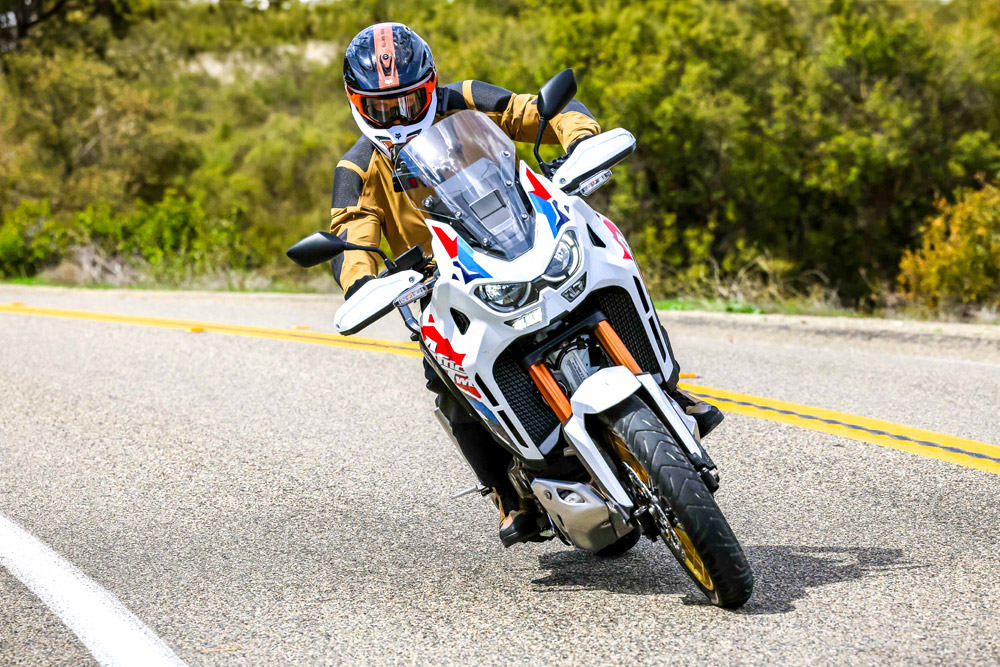
Locked and Loaded
Riding this fully loaded ADV weapon is comfortable and fun. The torque output is spirited enough to get you in and out of California’s most brutal traffic, and the open road lets the bike spin along smoothly. It’s also a capable and careful in-town commuter. It’s Apple CarPlay- and Android Auto-equipped to integrate into your smartphone and helmet headset and the touchscreen control is cool. The cruise control is simple and effective, and despite all the buttons on the bars, they all pretty much disappear if you just want to ride and experience what’s going on around you. Honda’s preset ride modes incorporate smart amounts of electronic rider aides, and their intrusion into your ride experience is minimal. Gone are the days when traction control was clunky and ABS integration was rough. DCT will make you relax on your ride, if you’re into that sort of thing, and the electronic suspension will be a smooth companion, as well. If I’m taking a trip across the open roads, paved or gravel, and hitting twisties, this is a great touring companion. It’s limited only in aggressive off-road situations, but those are for different bikes anyway.CN
VIDEO | 2025 Honda Africa Twin Adventure Sports ES DCT Ride Review
2025 Africa Twin Adventure Sports ES DCT Specifications
| MSRP | $18,399 |
| Engine | Parallel-twin, 4-stroke |
| Displacement | 1084cc |
| Bore x Stroke | 92mm x 81.5mm |
| Valvetrain | Unicam SOHC, 4 valves per cylinder |
| Fueling | PGM-FI electronic fuel injection (Throttle by Wire); 46mm throttle body |
| Electronics | Bosch MM7.10 six-axis IMU, Preset ride modes and suspension modes, customizable |
| Horsepower (Claimed) | 44 hp @ 8500 rpm |
| Torque (Claimed) | 32.5 lb-ft @ 6250 rpm |
| Transmission | 6-speed Automatic DCT |
| Clutch | No manual clutch |
| Frame | Steel frame and removable aluminum subframe |
| Handlebar | Tapered aluminum |
| Front Suspension | Showa upside-down 45mm fork, preload, compression & rebound electronically adjustable |
| Rear Suspension | Pro-Link single shock with electronic adjustment for compression, rebound and preload |
| Front-Wheel Travel | 8.3 in. |
| Rear-Wheel Travel | 7.9 in. |
| Front Brake | Dual 310mm petal-style floating rotors and radial-mount, four-piston calipers w/ lean-angle sensitive ABS |
| Rear Brake | 256mm petal-style disc w / lean-angle sensitive ABS, switchable |
| Front Wheel / Tire | Spoked tubeless / 110/80R-19 in. |
| Rear Wheel / Tire | Spoked tubeless / 150/70R-18 in. |
| Rake | 27.0° |
| Wheelbase | 61.8 in. |
| Seat Height | 32.9-33.7 in. |
| Fuel Capacity | 6.6 gal. |
| Weight (wet, claimed) | 559 full of fuel and standard equipment installed |
| Country of Origin | Japan |
Click here to read the 2025 Honda Africa Twin Adventure Sports ES DCT Review in the Cycle News Digital Edition Magazine.
Click here for the latest Cycle News Adventure motorcycle reviews and news.
Click here for more Honda motorcycle reviews and news.
